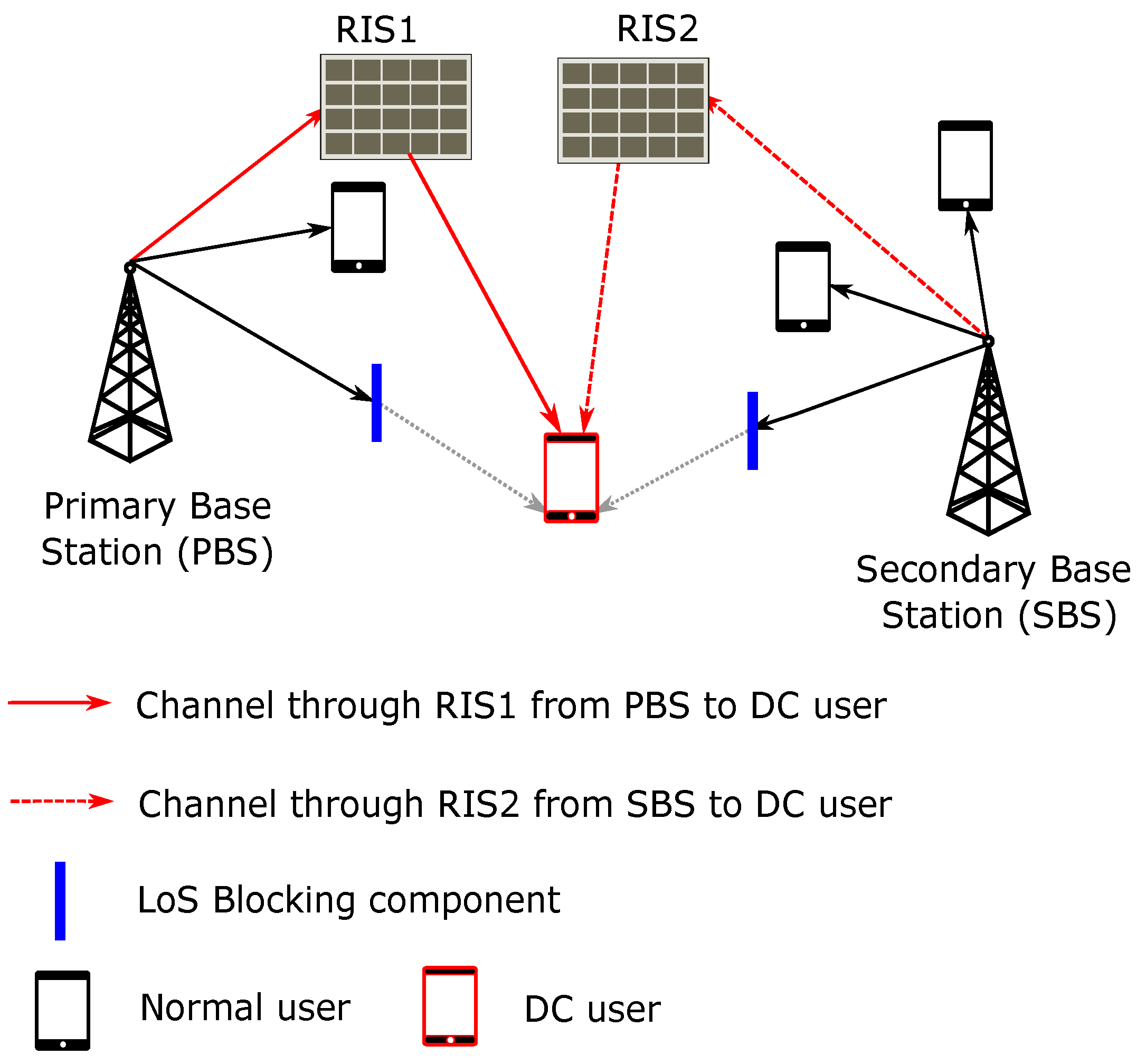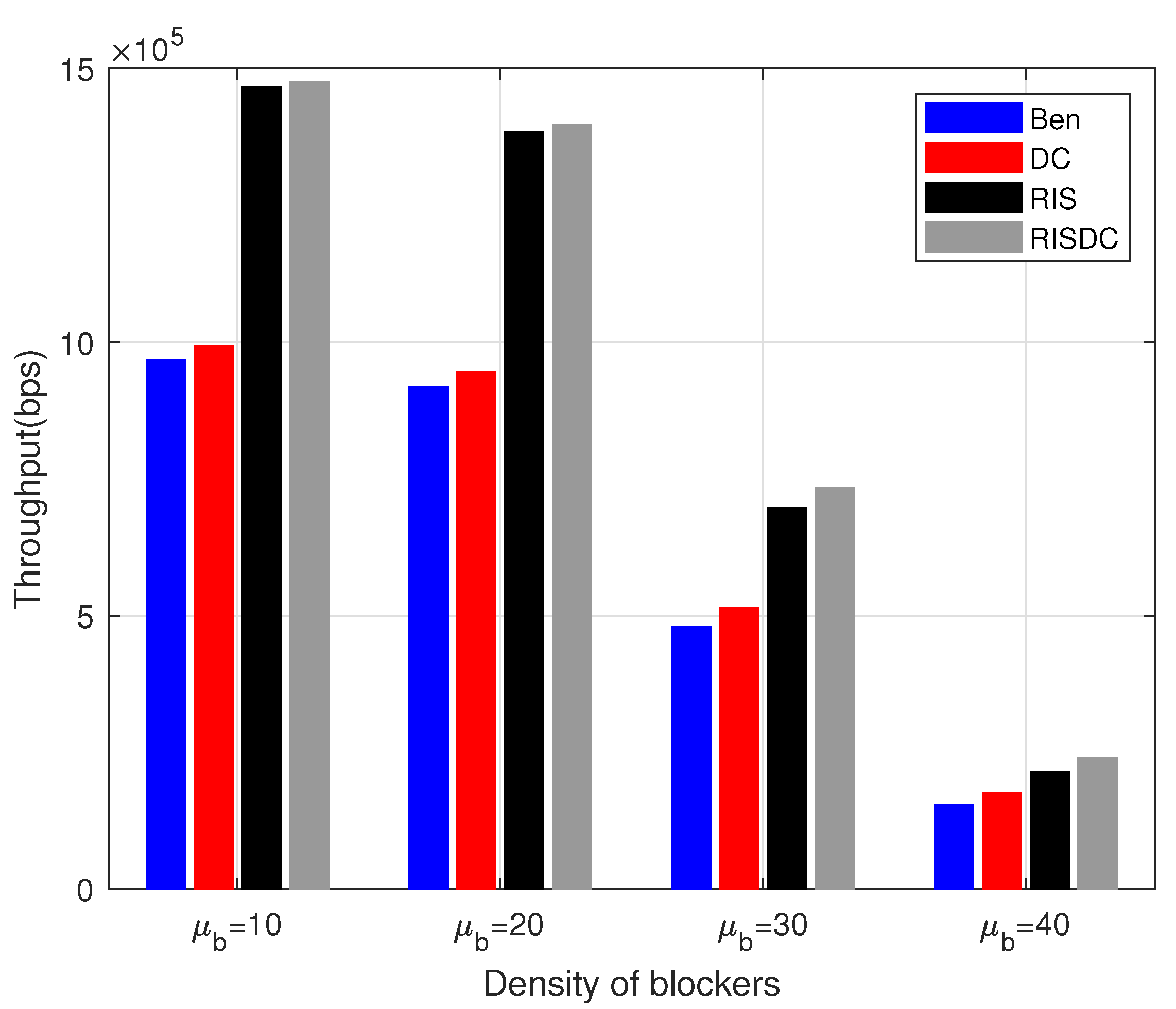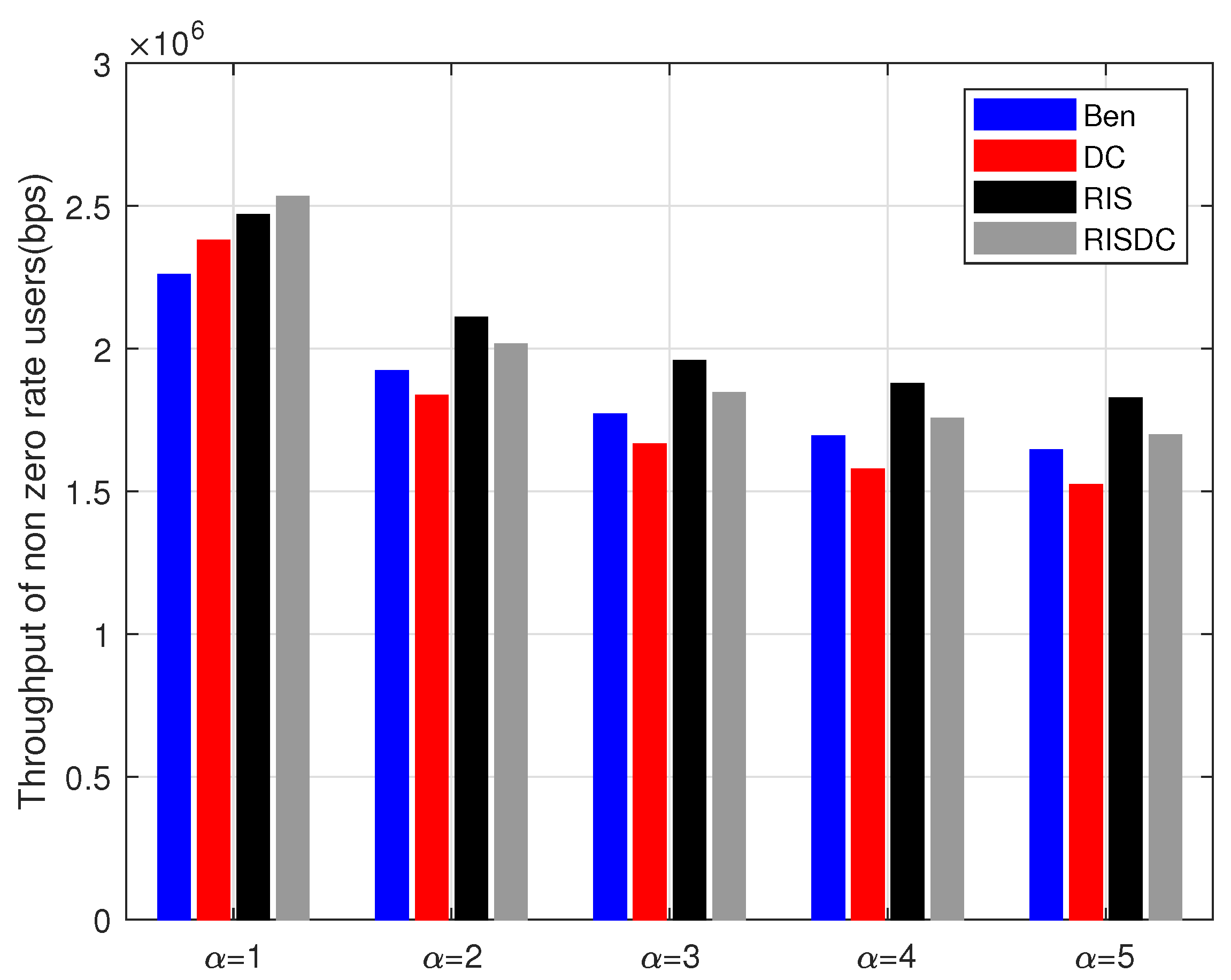Resource Allocation for Reconfigurable Intelligent Surface Assisted Dual Connectivity
Abstract
:1. Introduction
- The RIS-assisted DC architecture is proposed, which utilizes radio resources from two different BSs via two different RISs.
- The joint resource allocation of RIS-assisted DC is formulated as an optimization problem and the optimal user scheduling time fraction for RIS-assisted DC systems for an -fair scheduler is derived.
- The formulated joint problem is decomposed and the optimal user scheduling time fraction is derived using Karush–Kuhn–Tucker (KKT) conditions. A heuristic for solving the overall optimization problem with the derived scheduling time fraction is also presented.
- Exhaustive simulation results are presented for distributed RIS architecture with varying densities of users, BSs, and blockage densities are presented.
2. System Model
2.1. Physical Channel Model
2.2. Link Rate and Scheduling
2.3. RIS Channel Model and Scheduling
2.4. Performance Metrics
3. RIS Assisted Dual Connectivity
4. Proposed Heuristic for RIS Assisted DC
| Algorithm 1 Proposed heuristic for RIS-assisted DC |
|
5. Numerical Results
6. Conclusions and Future Work
Author Contributions
Funding
Institutional Review Board Statement
Informed Consent Statement
Data Availability Statement
Conflicts of Interest
References
- NTT DOCOMO. 5G Evolution and 6G, Japan; White Paper; NTT DOCOMO, Inc.: Tokyo, Japan, 2022. Available online: https://www.docomo.ne.jp/english/binary/pdf/corporate/technology/whitepaper_6g/DOCOMO_6G_White_PaperEN_v4.0.pdf (accessed on 25 July 2022).
- Tang, W.; Chen, M.Z.; Chen, X.; Dai, J.D.; Han, Y.; Di Renzo, M.; Zeng, Y.; Jin, S.; Cheng, Q.; Cui, T.J. Wireless Communications With Reconfigurable Intelligent Surface: Path Loss Modeling and Experimental Measurement. IEEE Trans. Wirel. Comm. 2021, 20, 421–439. [Google Scholar] [CrossRef]
- Di Renzo, M.; Zappone, A.; Debbah, M.; Alouini, M.S.; Yuen, C.; De Rosny, J.; Tretyakov, S. Smart Radio Environments Empowered by Reconfigurable Intelligent Surfaces: How It Works, State of Research, and The Road Ahead. IEEE J. Sel. Areas Commun. 2020, 38, 2450–2525. [Google Scholar] [CrossRef]
- Özdogan, E. Björnson; E.G. Larsson. Intelligent Reflecting Surfaces: Physics, Propagation, and Pathloss Modeling. IEEE Wirel. Comm. Lett. 2020, 9, 581–585. [Google Scholar] [CrossRef] [Green Version]
- El Mossallamy, M.A.; Zhang, H.; Song, L.; Seddik, K.G.; Han, Z.; Li, G.Y. Reconfigurable Intelligent Surfaces for Wireless Communications: Principles, Challenges, and Opportunities. IEEE Trans. Cogn. Commun. 2020, 6, 990–1002. [Google Scholar] [CrossRef]
- Xie, H.; Xu, J.; Liu, Y.F. Max-Min Fairness in RIS-Aided Multi-Cell MISO Systems With Joint Transmit and Reflective Beamforming. IEEE Trans. Wirel. Commun. 2021, 20, 1379–1393. [Google Scholar] [CrossRef]
- Pan, C.; Ren, H.; Wang, K.; Xu, W.; Elkashlan, M.; Nallanathan, A.; Hanzo, L. Multicell MIMO Communications Relying on Intelligent Reflecting Surfaces. IEEE Trans. Wirel. Commun. 2020, 19, 5218–5233. [Google Scholar] [CrossRef]
- Li, Z.; Hua, M.; Wang, Q.; Song, Q. Weighted Sum-Rate Maximization for Multi-RIS Aided Cooperative Transmission. IEEE Wirel. Comm. Lett. 2020, 9, 1620–1624. [Google Scholar] [CrossRef]
- Mu, X.; Liu, Y.; Guo, L.; Lin, J.; Schober, R. Joint Deployment and Multiple Access Design for Intelligent Reflecting Surface Assisted Networks. IEEE Trans. Wirel. Commun. 2021, 20, 6648–6664. [Google Scholar] [CrossRef]
- Zuo, J.; Liu, Y.; Qin, Z.; Al-Dhahir, N. Resource Allocation in Intelligent Reflecting Surface Assisted NOMA Systems. IEEE Trans. Commun. 2020, 68, 7170–7183. [Google Scholar] [CrossRef]
- Hua, M.; Wu, Q.; Ng, D.W.K.; Zhao, J.; Yang, L. Intelligent Reflecting Surface-Aided Joint Processing Coordinated Multipoint Transmission. IEEE Trans.Commun. 2021, 69, 1650–1665. [Google Scholar] [CrossRef]
- Chen, Y.; Wang, Y.; Zhang, J.; Li, Z. Resource Allocation for Intelligent Reflecting Surface Aided Vehicular Communications. IEEE Trans. Veh. Technol. 2020, 69, 12321–12326. [Google Scholar] [CrossRef]
- Zappone, A.; Di Renzo, M.; Xi, X.; Debbah, M. On the Optimal Number of Reflecting Elements for Reconfigurable Intelligent Surfaces. IEEE Wirel. Comm. Lett. 2021, 10, 464–468. [Google Scholar] [CrossRef]
- Yang, Y.; Zhang, S.; Zhang, R. RIS-Enhanced OFDMA: Joint Resource Allocation and Passive Beamforming Optimization. IEEE Wirel Comm. Lett. 2020, 9, 760–764. [Google Scholar] [CrossRef] [Green Version]
- Yang, Y.; Zheng, B.; Zhang, S.; Zhang, R. Intelligent Reflecting Surface Meets OFDM: Protocol Design and Rate Maximization. IEEE Trans. Commun. 2020, 68, 4522–4535. [Google Scholar] [CrossRef] [Green Version]
- Guo, Y.; Qin, Z.; Liu, Y.; Al-Dhahir, N. Intelligent Reflecting Surface Aided Multiple Access Over Fading Channels. IEEE Trans. Commun. 2021, 69, 2015–2027. [Google Scholar] [CrossRef]
- Du, H.; Zhang, J.; Cheng, J.; Ai, B. Millimeter Wave Communications With Reconfigurable Intelligent Surfaces: Performance Analysis and Optimization. IEEE Trans. Commun. 2021, 69, 2752–2768. [Google Scholar] [CrossRef]
- 3GPP. Overview of 3GPP Release 123. GPP RP 151570; V0.2.0. 2015. Available online: https://www.3gpp.org/ftp/TSG_RAN/TSG_RAN/TSGR_69/Docs (accessed on 25 July 2022).
- Pan, M.S.; Lin, T.M.; Chiu, C.Y.; Wang, C.Y. Downlink traffic scheduling for LTE-A small cell networks with dual connectivity enhancement. IEEE Commun. Lett. 2016, 20, 796–799. [Google Scholar] [CrossRef]
- Ramamoorthi, Y.; Kumar, A. Performance comparison of dual connectivity with CoMP in heterogeneous cellular networks. In Proceedings of the 2017 9th International Conference on Communication Systems and Networks (COMSNETS), Bengaluru, India, 4–8 January 2017; pp. 237–242. [Google Scholar] [CrossRef]
- Ramamoorthi, Y.; Kumar, A. Resource Allocation for CoMP in Cellular Networks With Base Station Sleeping. IEEE Access 2018, 6, 12620–12633. [Google Scholar] [CrossRef]
- Björnson, E.; Özdogan, Ö.; Larsson, E.G. Intelligent Reflecting Surface Versus Decode-and-Forward: How Large Surfaces are Needed to Beat Relaying? IEEE Wireless Comm. Lett. 2020, 9, 244–248. [Google Scholar] [CrossRef] [Green Version]
- 3GPP TR 38.901, v17.0.0.; Technical Specification Group Radio Access Network; Study on channel model for frequencies from 0.5 to 100 GHz. Available online: https://portal.3gpp.org/desktopmodules/Specifications/SpecificationDetails.aspx?specificationId=3173 (accessed on 28 July 2022).










| Direct channel gain at user u from BS j | |
| Channel gain at user u from BS j via RIS r | |
| Direct link rate of user u from BS j | |
| Link rate of user u from BS j via RIS r | |
| Binary user association variable of user | |
| u with BS j without RIS | |
| Binary user association variable of user | |
| u with BS j via RIS | |
| Fairness parameter for the -Fair scheduler | |
| User scheduling time fraction for user u by BS j without RIS | |
| User scheduling time fraction for user u by BS j via RIS r | |
| Spectral efficiency in | |
| Blockage density | |
| DL received SINR of user u from a BS j | |
| DL received SINR of user u from a BS j via RIS r | |
| Number of BSs | |
| Number of users | |
| Utility function | |
| Binary association variable for DC user | |
| Data rate of user u | |
| Reflection amplitude of antenna element of RIS | |
| Phase shift of of antenna element of RIS | |
| Throughput |
| 28 GHz | |
| Penetration loss () | 20 dB for NLOS path |
| Loss due to shadowing () | Standard deviation of 4 dB |
| P | 30 dBm |
| PL(d) | Urban micro [23] |
| C | 99 |
| Subchannel Bandwidth | 720 KHz |
| SC | 12 |
| SY | 14 |
| T | 0.25 ms |
Publisher’s Note: MDPI stays neutral with regard to jurisdictional claims in published maps and institutional affiliations. |
© 2022 by the authors. Licensee MDPI, Basel, Switzerland. This article is an open access article distributed under the terms and conditions of the Creative Commons Attribution (CC BY) license (https://creativecommons.org/licenses/by/4.0/).
Share and Cite
Ramamoorthi, Y.; Iwabuchi, M.; Murakami, T.; Ogawa, T.; Takatori, Y. Resource Allocation for Reconfigurable Intelligent Surface Assisted Dual Connectivity. Sensors 2022, 22, 5755. https://doi.org/10.3390/s22155755
Ramamoorthi Y, Iwabuchi M, Murakami T, Ogawa T, Takatori Y. Resource Allocation for Reconfigurable Intelligent Surface Assisted Dual Connectivity. Sensors. 2022; 22(15):5755. https://doi.org/10.3390/s22155755
Chicago/Turabian StyleRamamoorthi, Yoghitha, Masashi Iwabuchi, Tomoki Murakami, Tomoaki Ogawa, and Yasushi Takatori. 2022. "Resource Allocation for Reconfigurable Intelligent Surface Assisted Dual Connectivity" Sensors 22, no. 15: 5755. https://doi.org/10.3390/s22155755
APA StyleRamamoorthi, Y., Iwabuchi, M., Murakami, T., Ogawa, T., & Takatori, Y. (2022). Resource Allocation for Reconfigurable Intelligent Surface Assisted Dual Connectivity. Sensors, 22(15), 5755. https://doi.org/10.3390/s22155755






